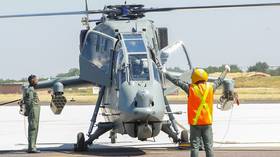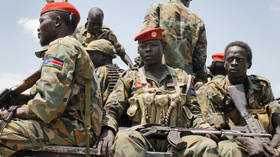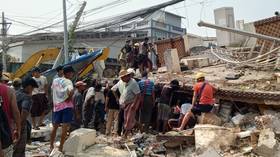After Hong Kong, China’s new priority is Taiwan and Beijing aims to wear it down in an intense war of attrition
Tensions are escalating between Beijing and Taipei, but military conflict is unlikely given the US would intervene. China’s preferred tactic is to play the long game and engage the island in a political battle of wills.
One of the biggest potential flashpoints in the world right now is the Taiwan Strait. As tensions between the United States and China have surged, the geopolitical fate of the self-ruled island of Taiwan has become pivotal in the ‘new cold war.’
Beijing has maintained the longstanding position that the island, the de-facto continuation of China’s previous government, the Republic of China, is a breakaway province which ought to be reunified with the rest of the country.
Also on rt.com Hong Kong protest hero Joshua Wong trained alongside the cream of Western-backed colour revolutionariesTaiwan itself, having been under separate rule from the mainland since 1949, increasingly sees itself as something different, especially given that it has developed a democratic system. Under the rule of Tsai Ing-wen and the Democratic Progressive Party (DPP), it has increasingly sought to assert its position towards ‘formal independence,’ backed by the US.
This has resulted in an escalation of military tensions, with Beijing engaging in frequent air force exercises near the island, while Washington has secured a record number of arms sales to Taipei.
The result has been a lot of talk that China may launch a formal invasion of Taiwan, which it has never ruled out. But is that plausible? And what is likely to happen? A comprehensive analysis from Reuters on Friday set out a different thesis, arguing that while Beijing is not about to invade the island, it has been waging a hybrid “gray zone” warfare against it, which might be more accurately described as a “war of attrition.”
It is quite right to point out that although Beijing could feasibly win a conflict in the Taiwan Strait – even accounting for US intervention – the costs would be high. Still, whose side is time on? With Hong Kong now ‘pacified,’ it’s obvious where China’s next priority lies.
The mainstream media and western commentators like to portray China as the aggressor when it comes to Taiwan, as they did with Hong Kong and do with pretty much everything else. Of course, the size of the island and the fact it is generally inoffensive wins it a lot of sympathy, but this is a far more complex situation than an unnuanced struggle between ‘good and evil’ as it is assumed.
Beijing perceives the division of Taiwan from China’s territory as a historical injustice which needs to be corrected. The legacy of western imperialism means that Beijing has built the People’s Republic of China’s national identity around the fabric of ‘reunification’ –restoring the Chinese nation to its rightful state against the background of historical humiliation.
The return of Hong Kong to China, and the subsequent affirmation of Beijing’s sovereignty over it, were both seen as rightful steps in this direction. Now that the Hong Kong protest movement is over, the demise of pro-democracy tycoon Jimmy Lai being another nail in its coffin, logic suggests that Beijing will turn to Taipei next. This is really the only problem on China’s doorstep left.
It is not just a simple issue of national pride, but a strategic one: Beijing has long been wary of ‘strategic encirclement’ by adversarial states who have sought to surround China’s periphery, and has responded accordingly, taking a hard line if needed. In 1950, Beijing intervened in the Korean War to stop the US-led coalition from occupying the entire Korean peninsula and bringing an end to the state of North Korea.
In 1962, China went to war against India in order to quell its tilt towards the Soviet Union. In 1979, it also went to war against Vietnam for the same reason, and in 2020, it once again engaged in border tensions with New Delhi to check its growing ties with the US.
Also on rt.com China’s latest sanctions are a bid to permanently end America’s interference in Hong KongAs a result, the presence on its border of Taiwan, which is becoming ever more politically unfavourable to Beijing and looking towards Washington, is a strategic liability and ideological challenge which needs to be dealt with. Although ties between Taipei and Beijing were warm under the pro-China Kuomintang (KMT) government in previous years, the DPP’s politics of independence now comprise the centre ground.
So what is to be done? The risks of using force are tremendous, given the potential intervention by Washington, economic shockwaves and wider disapproval in the west. This does not mean, however, that China is unprepared to up the ante. Instead we can expect a war of attrition where the aim is simply to overwhelm Taipei by constant provocations, a shift in the balance of power and depletion of resources.
For example, having to scramble jets had cost Taiwan nearly $1 billion as of October, plus there is the expense of the ever growing munitions purchases from the US military-industrial complex. The Reuters analysis suggests that Taiwan may opt for its largest increase in defence spending ever. Given the obvious difference in size and resources with China, one has to feasibly question how does Taiwan keep up the pace? And what other expenditure does this take away from?
And so, it is possible that in the long run China’s aim will be to sap Taiwan’s morale and will to resist Beijing’s political pull. While there is support from the US in the background, what can it do to stop this? Although America acts as a restraint for Beijing, Washington itself cannot push too far in its support without risking conflict. And it is also likely to be contemplating the changing balance of power as China’s own capabilities and economy grow.
Given all this, while the island arguably has a lot of resolve, China is pushing it into a marathon battle of wills, and ultimately hopes to make it stumble without firing a single shot.
Think your friends would be interested? Share this story!
The statements, views and opinions expressed in this column are solely those of the author and do not necessarily represent those of RT.















